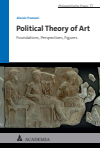Zusammenfassung
Das Buch trägt mit einer originellen und umfassenden Theorie zur Debatte über das Verhältnis von Ästhetik und Politik bei. Politische Theorie ist, wie Fransoni klarstellt, keine Theorie der Politik, sondern eine Theorie, die Dinge, hier die Kunst, im Lichte des Politischen, d.h. im Sinne menschlicher Pluralität begreift. Im Lichte des Politischen finden das Kunstwerk und andere gängige Begriffe der Kunstkritik neue und überraschende Definitionen. Zugleich wird deutlich, wie das Kunstwerk entscheidende Beziehungen des Politischen, etwa zwischen Freiheit und Welt, manifestiert. Eine politische Theorie betrachtet Kunst letztlich aus der gleichen Perspektive der Pluralität, die Kunst zusammen mit anderen Konzepten des Politischen zu definieren hilft.
Abstract
The book enters the debate on the relationship between aesthetics and politics with an original and comprehensive theory. As Fransoni makes clear, a political theory is not a theory of politics, but a theory that deals with things, in this case art, in order to read them in the light of the political, i.e. in relation to human plurality. In the light of the political, the work of art and other common notions of art criticism find new and surprising definitions. At the same time, it is revealed how the work of art manifests some of the crucial relationships of politics, such as that between freedom and world. A political theory ultimately looks at art from the same perspective of plurality that art, together with other concepts of the political, helps to define.
Schlagworte
Ästhetik aesthetics art Beziehungen art criticism Fransoni Freiheit art theory foundations Grundlagen Kunst freedom Kunstkritik personalities perspectives Kunsttheorie plurality Persönlichkeiten plurality perspective Perspektiven political theory of art Pluralität politics Pluralitätsperspektive relationships Politik theory politische Kunsttheorie Theorie- 57–98 Part III. Figures 57–98
- 99–103 Reference list 99–103

